Okay so in response to your comments, I've created a simplified Django app to demonstrate a solution,
Note: I've removed all but one foreign key and corresponding values from the table, and I've also merged all the templates into one (without any styling).
The source code can be found here:
https://github.com/kujosHeist/stack-overflow-django
There's surely better ways to do this, but my solution is that every time the Add button is clicked, the table gets updated with the values, and the values are stored in an object list.
Then when Submit is clicked, it loops through the object list and posts the data to the backend to be stored.
There is a way to send the whole object list together, but django/ajax treats lists awkwardly, so sending them separately is easier for now.
Also, I am manually creating the objects in the backend, rather than using the form, but there should be a way to store the JavaScript objects in a FormData object before posting, so that you can use form.is_valid() and form.save(),
but again for simplicity I avoided that.
index.html
<!-- Latest compiled and minified CSS -->
<link rel="stylesheet" href="https://maxcdn.bootstrapcdn.com/bootstrap/3.3.7/css/bootstrap.min.css" integrity="sha384-BVYiiSIFeK1dGmJRAkycuHAHRg32OmUcww7on3RYdg4Va+PmSTsz/K68vbdEjh4u" crossorigin="anonymous">
<!-- Optional theme -->
<link rel="stylesheet" href="https://maxcdn.bootstrapcdn.com/bootstrap/3.3.7/css/bootstrap-theme.min.css" integrity="sha384-rHyoN1iRsVXV4nD0JutlnGaslCJuC7uwjduW9SVrLvRYooPp2bWYgmgJQIXwl/Sp" crossorigin="anonymous">
<div class="right_col" role="main">
<h1 class="text-center">Stock</h1>
<div class="space"></div>
<form class="stock-form form-group">
{% csrf_token %}
{{ form.as_p }}
<input type="submit" name="Submit">
</form>
<button class="btn btn-primary add-stock" id="add-button">Add</button>
</div>
<div class="stock-list">
<table class="table table-striped stock-table">
<thead>
<tr>
<th>#</th>
<th>Item</th>
<th>Miti</th>
<th>Quantity</th>
<th>Value</th>
<th>Specification</th>
<th>Remarks</th>
</tr>
</thead>
<tbody id="table-body">
<!-- here how should i show all those added items -->
</tbody>
</table>
</div>
<script
src="https://code.jquery.com/jquery-3.2.1.min.js"
integrity="sha256-hwg4gsxgFZhOsEEamdOYGBf13FyQuiTwlAQgxVSNgt4="
crossorigin="anonymous"></script>
<!-- Latest compiled and minified JavaScript -->
<script src="https://maxcdn.bootstrapcdn.com/bootstrap/3.3.7/js/bootstrap.min.js" integrity="sha384-Tc5IQib027qvyjSMfHjOMaLkfuWVxZxUPnCJA7l2mCWNIpG9mGCD8wGNIcPD7Txa" crossorigin="anonymous"></script>
<script>
var itemCount = 0;
var objList = [];
$(document).ready(function() {
$("#add-button").on("click", function(){
// store values in object and add them to list
var obj = {};
obj['date'] = $('#id_miti').val();
obj['item_id'] = $('#id_item').val();
// (adding itemCount to values so all they all aren't the same)
obj['quantity'] = $('#id_quantity').val() + itemCount;
obj['value'] = $('#id_value').val() + itemCount;
obj['specification'] = $('#id_specification').val();
obj['remarks'] = $('#id_remarks').val();
objList.push(obj);
// get item name for displaying in table
var e = document.getElementById("id_item");
var itemName = e.options[e.selectedIndex].innerText;
// add object to table
$("#table-body").append("<tr>");
$("#table-body").append("<td>" + itemName + "</td>");
$("#table-body").append("<td>" + (itemCount++) + "</td>");
$("#table-body").append("<td>" + obj['date'] + "</td>");
$("#table-body").append("<td>" + obj['quantity'] + "</td>");
$("#table-body").append("<td>" + obj['value'] + "</td>");
$("#table-body").append("<td>" + obj['specification'] + "</td>");
$("#table-body").append("<td>" + obj['remarks'] + "</td>");
$("#table-body").append("</tr>");
console.log("Added object to table:")
console.log(obj);
});
$('.stock-form').submit(function(e) {
e.preventDefault();
if(objList.length > 0){
var token = "{{csrf_token}}";
// loop through object list and post to back end
// could send them all together, but ajax/django handles list of objects
// awkwardly
for(var i = 0; i < objList.length; i++){
var data = objList[i];
data['csrfmiddlewaretoken'] = token
$.ajax({
type: 'post',
url: '',
data: data,
success: function(data) {
console.log("Success!")
console.log('data', data);
}
});
}
}
});
});
</script>
views.py
from django.shortcuts import render, redirect
from django.core.urlresolvers import reverse
import json
from .models import OpeningStock, Item
from django.http import HttpResponse
from .forms import OpeningStockForm
from dateutil import parser
def index(request):
form = OpeningStockForm(request.POST or None)
if request.method == "POST":
# manually retrieve fields and create object
data = request.POST
date = parser.parse(data['date'])
# get item from db, make sure you add some sample items to the db
item = Item.objects.get(pk=data["item_id"])
s = OpeningStock(item=item, miti=date, quantity=data['quantity'], value=data['value'], specification=data['specification'], remarks=data['remarks'])
s.save()
return HttpResponse(json.dumps({'result': 'success', 'data': request.POST}))
else:
context = {}
context['form'] = form
return render(request, 'question1/index.html', context)
models.py
from django.db import models
from django.utils import timezone
class Item(models.Model):
name = models.CharField(max_length=32)
class OpeningStock(models.Model):
item = models.ForeignKey(Item, blank=True, null=True)
miti = models.DateTimeField(null=True, default=timezone.now)
quantity = models.PositiveIntegerField(default=34)
value = models.DecimalField(default=2.5, max_digits=100, decimal_places=2)
specification = models.CharField(blank=True, null=True, max_length=600, default="Sample Spec")
remarks = models.TextField(blank=True, null=True, default="Sample remarks")
forms.py
from django.forms import ModelForm
from django import forms
from .models import Item
from question1.models import OpeningStock
class OpeningStockForm(ModelForm):
item = forms.CharField(
widget=forms.Select(
choices=Item.objects.all().values_list('id', 'name')
)
)
class Meta:
model = OpeningStock
fields = ["item","miti","quantity","value","specification","remarks"]
urls.py
from django.conf.urls import url
from . import views
urlpatterns = [
url(r'^$', views.index, name="index"),
]
